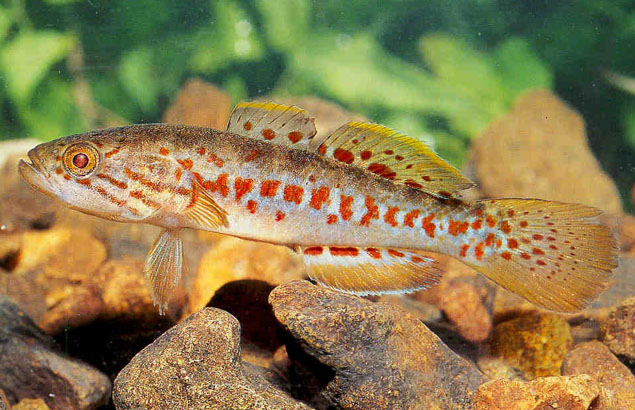- Classification
- ACTINOPTERYGII
- PERCIFORMES
- ELEOTRIDAE
- Mogurnda
- oligolepis
Kimberley Mogurnda, Mogurnda oligolepis Allen & Jenkins 1999

Kimberley Mogurnda, Mogurnda oligolepis. Source: Gerald R. Allen. License: All rights reserved
Kimberley Mogurnda, Mogurnda oligolepis Allen & Jenkins 1999
More Info
|
Distribution |
Endemic to the Kimberley region of Western Australia, west of the Pentecost River. Inhabits creeks, billabongs and rocky pools, usually among vegetation and submerged in quiet waters. |
|
Features |
Dorsal fin VII-VIII + I, 9-12; Anal fin I, 9-12; Caudal fin (segmented rays) 13-15; (branched rays) 13-15; Pectoral fin 14-16; Pelvic fin I, 5; Transverse scales 11-13; Gill rakers 2 + 8 =10; Vertebrae 13-15 + 15-17 = 29-31. Body elongate, laterally compressed, more strongly posteriorly; depth 3.6-4.7 in SL; caudal peduncle relatively elongate. Head more or less pointed with straight to slightly convex snout; nape moderately arched; length 2.6-3.1 in SL. Eye diameter 12.08-15.4 in SL. Lower jaw protruding, mouth oblique, reaching to anterior edge of pupil; jaws with villiform, posteriorly curved teeth, in dense bands, outer row enlarged; palate without teeth. Gill opening extending nearly to below rear margin of eye. Sensory pores absent on head, but well developed system of papillae arranged in multiserial bands. Sexual dimorphism generally inconspicuous. Head and body covered with scales, except lips, snout tip, preorbital region, lower jaw, and chin; those on head, predorsal region, breast, uppermost part of back and bases of caudal and pectoral fins cycloid, remainder finely ctenoid; lateral line absent; scales in lateral series 31-37; predorsal scales 16-20. Two dorsal fins, first rounded and lower than second, with slender, flexible spines; second dorsal and anal fins similar and opposite. Pectoral fin rounded. Pelvic fins separate, pointed. Caudal fin rounded. |
|
Size |
To at least 8 cm SL. |
|
Colour |
Dark brown on back and top of head, tan or whitish to pale mauve ventrally; head with three distinct red, diagonal stripes including a pair from lower edge of eye to lower rear edge of operculum, and third across middle of operculum through middle of pectoral fin base; also short, upward deflected, red stripe from upper rear corner of eye; middle of sides with series of about 11 large, rectangular red blotches between bases of pectoral and caudal fins; spaces between red blotches bluish-white; additional, smaller red spots scattered on body, especially on side of nape and above belly. Dorsal fins semi-translucent to slightly dusky brown with relatively broad yellow outer margin, 3-4 large red spots along base of second dorsal and several smaller red spots medially on first and second dorsal fins; anal fin semi-translucent with yellow-brown tinge, its outer margin narrowly white and basal portion broadly white superimposed with 4-5 red spots; caudal fin semi-translucent with yellow-brown tinge and red spotting, spots larger and concentrated medially and basally; pectoral and pelvic fins semitranslucent to slightly dusky brown. |
|
Feeding |
Likely to feed on small crustaceans and other invertebrates. |
|
Biology |
Oviparous, benthic spawners. |
|
Etymology |
The specific name is from the Greek oligolepis (= few-scales), in reference to the low lateral scale count of this species, a feature distinguishing it from M. mogurnda. |
|
Species Citation |
Mogurnda oligolepis Allen & Jenkins 1999, Aqua, J. Ichthyol. Aquat. Biol. 3(4): 151, fig. 9. Type locality: Mogurnda Creek, about 15°03'S, 126°52'E, tributary of Drysdale River, Drysdale River National Park, Kimberley District, Western Australia. |
|
Author |
Gomon, M.F. & Bray, D.J. 2024 |
|
Resources |
Kimberley Mogurnda, Mogurnda oligolepis Allen & Jenkins 1999
References
Allen, G.R. 1982. Inland Fishes of Western Australia. Perth : Western Australian Museum 86 pp. 6 figs 20 pls. (as M. species)
Allen, G.R. & Jenkins, A.P. 1999. A review of the Australian freshwater gudgeons, genus Mogurnda (Eleotridae) with descriptions of three new species. Aqua, Journal of Ichthyology and Aquatic Biology 3(4): 141-155
Allen, G.R. & Leggett, R. 1990. A collection of freshwater fishes from the Kimberley region of Western Australia. Records of the Western Australian Museum 14(4): 527-545 fig. 1 (as Mogurnda mogurnda)
Allen, G.R., Midgley, S.H. & Allen, M. 2002. Field Guide to the Freshwater Fishes of Australia. Perth : Western Australian Museum 394 pp.
Moore, G. 2019. Mogurnda oligolepis. The IUCN Red List of Threatened Species 2019: e.T123359701A123382881. https://dx.doi.org/10.2305/IUCN.UK.2019-3.RLTS.T123359701A123382881.en. Accessed on 29 January 2024.
Morgan, D.L. 2010. Fishes of the King Edward River in the Kimberley region, Western Australia. Records of the Western Australian Museum 25: 351–368
Morgan, D.L., Allen, M.G., Bedford, P. & Horstman, M. 2004. Fish fauna of the Fitzroy River in the Kimberley region of Western Australia -- including the Bunuba, Gooniyandi, Ngarinyin, Nyikina and Walmajarri Aboriginal names. Records of the Western Australian Museum 22(2): 147-161. https://doi.org/10.18195/issn.0312-3162.22(2).2004.147-161
Morgan, D.L., Allen, G.R., Pusey, B.J. & Burrows, D.W. 2011. A review of the freshwater fishes of the Kimberley region of Western Australia. Zootaxa 2816: 1-64. https://doi.org/10.11646/zootaxa.2816.1.1
Shelley, J.J. & Le Feuvre, M.C. 2018. Family Eleotridae. pp. 174-203 in Shelley, J.J., Morgan, D.L., Hammer, M.P., Le Feuvre, M.C., Moore, G.I., Gomon, M.F., Allen, M.G. & Saunders, T. (eds). A field guide to the freshwater fishes of the Kimberley. Murdoch, Western Australia : Murdoch University 262 pp.






